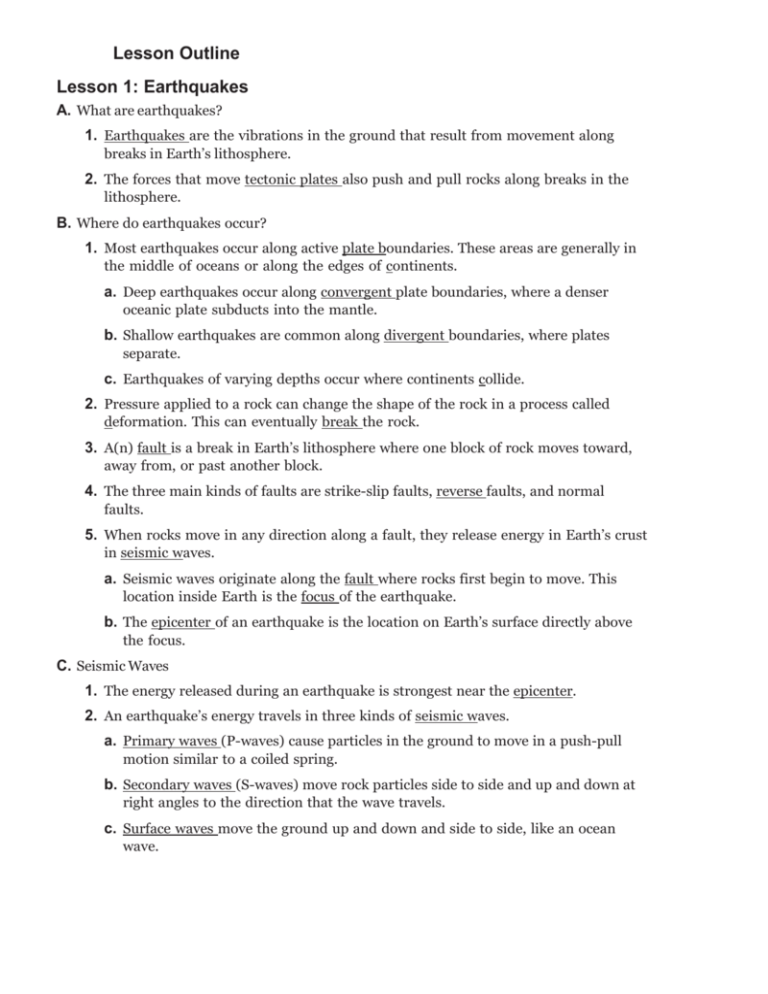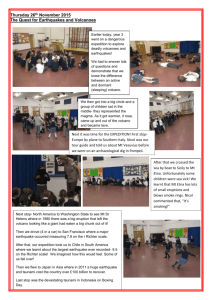Lesson 2: Volcanoes
advertisement

Lesson Outline continued Lesson 1: Earthquakes A. What are earthquakes? 1. Earthquakes are the vibrations in the ground that result from movement along breaks in Earth’s lithosphere. 2. The forces that move tectonic plates also push and pull rocks along breaks in the lithosphere. B. Where do earthquakes occur? 1. Most earthquakes occur along active plate boundaries. These areas are generally in the middle of oceans or along the edges of continents. a. Deep earthquakes occur along convergent plate boundaries, where a denser oceanic plate subducts into the mantle. b. Shallow earthquakes are common along divergent boundaries, where plates separate. c. Earthquakes of varying depths occur where continents collide. 2. Pressure applied to a rock can change the shape of the rock in a process called deformation. This can eventually break the rock. 3. A(n) fault is a break in Earth’s lithosphere where one block of rock moves toward, away from, or past another block. 4. The three main kinds of faults are strike-slip faults, reverse faults, and normal faults. 5. When rocks move in any direction along a fault, they release energy in Earth’s crust in seismic waves. a. Seismic waves originate along the fault where rocks first begin to move. This location inside Earth is the focus of the earthquake. b. The epicenter of an earthquake is the location on Earth’s surface directly above the focus. C. Seismic Waves 1. The energy released during an earthquake is strongest near the epicenter. 2. An earthquake’s energy travels in three kinds of seismic waves. a. Primary waves (P-waves) cause particles in the ground to move in a push-pull motion similar to a coiled spring. b. Secondary waves (S-waves) move rock particles side to side and up and down at right angles to the direction that the wave travels. c. Surface waves move the ground up and down and side to side, like an ocean wave. Lesson Outline continued D. Mapping Earth’s Interior 1. Scientists who study earthquakes are called seismologists. 2. Seismic waves travel at different speeds and in different directions, depending on the materials they travel through. 3. S-waves cannot travel through liquids, including Earth’s outer core. 4. Seismic waves slow down as they travel through hot material. From this information, scientists model convection currents in Earth’s mantle. 5. A(n) seismometer measures and records how much the ground moves and can be used to determine the distance seismic waves travel. 6. A(n) seismogram is a graphical illustration of seismic waves. E. Determining Earthquake Magnitude 1. The Richter magnitude scale uses the amount of motion at a given distance from an earthquake to determine the magnitude of the earthquake. 2. The moment magnitude scale measures the amount of energy released by an earthquake. 3. The Modified Mercalli scale measures earthquake intensity based on descriptions of the earthquake’s effects on people and structures. 4. In the United States, most earthquakes occur near transform faults and convergent plate boundaries. 5. Seismologists assess earthquake risk based on past earthquake activity, the geology around a fault, population density, and building design. Discussion Question What is the risk of significant earthquake damage where you live? What is this risk assessment based on? Places close to plate boundaries, including the West Coast and Alaska, and places close to the New Madrid fault in Missouri have the highest risk. Refer to Figure 7 in your textbook for information about earthquake risks in your region. The risk assessment is based on distance relative to plate boundaries or other fault lines, the frequency and magnitude of earthquakes in the past, the geology of the region, population density, and building design. Lesson Outline continued Lesson 2: Volcanoes A. What is a volcano? 1. A(n) volcano is a vent in Earth’s crust through which molten rock flows. 2. Molten rock below Earth’s surface is called magma. B. How do volcanoes form? 1. Volcanoes can form along convergent plate boundaries, when one plate subducts under another. a. Magma from the hot mantle rises through cracks in the crust and forms a volcano. b. Molten rock that erupts onto Earth’s surface is called lava. 2. At divergent plate boundaries, magma rises in cracks between the two plates, forming volcanoes. 3. Volcanoes that are not associated with plate boundaries are called hot spots. 4. Geologists theorize that hotspots form over plumes, which are places where hot magma rises due to convection currents in the mantle. C. Where do volcanoes form? 1. Most volcanoes occur on or along plate boundaries. 2. The Ring of Fire is the area of earthquake and volcanic activity that surrounds the Pacific Ocean. 3. Most volcanoes in the United States occur near the Pacific coast. D. Types of Volcanoes 1. Cinder cones are small, steep-sided volcanoes that erupt gas-rich, basaltic lavas. 2. Composite volcanoes are large, steep-sided volcanoes that result from explosive eruptions of andesitic and rhyolitic lava along convergent plate boundaries. 3. Shield volcanoes are large, gentle-sloped volcanoes that result from quiet eruptions of basaltic lavas along divergent plate boundaries and oceanic hot spots. 4. Lava flows travel slowly and rarely are deadly; they can last for many months or longer. 5. Volcanic ash can explode out of a volcano up to 40 km into the air. 6. Mudflows form when thermal energy from an erupting volcano melts snow. The meltwater can mix with mud and ash from the volcano, and it flows downhill. 7. A(n) pyroclastic flow is a fast-moving avalanche of hot gas, ash, and volcanic rock. 8. Volcanic eruptions can be predicted by studying changes in the ground and patterns of earthquakes. Lesson Outline continued E. Volcanic Eruptions 1. Volcanic ash, made up of tiny particles of pulverized volcanic rock and glass, erupts explosively. 2. The eruption style of a volcano depends on the amount of gases dissolved in the magma, especially the amount of dissolved water vapor. 3. Viscosity is a fluid’s resistance to flow. Viscosity of lava is higher when the magma has a high silica content. 4. As magma rises toward Earth’s surface, the pressure on it decreases. Bubbles of gas form and rise in the magma. The bubbles affect the explosiveness of lava and the type of rock that forms as lava cools. F. Volcanic Eruptions and Climate Change 1. The release of a large amount of volcanic ash can affect Earth’s climate by blocking sunlight. 2. When droplets of sulfuric acid from volcanoes form in the atmosphere, they reflect sunlight into space. 3. Volcanic ash and acid droplets in the atmosphere cool Earth’s climate. Discussion Question Why might the eruption of a large volcano pose a threat to many life-forms on Earth? Large volcanoes can send out large amounts of volcanic ash, which blocks sunlight. This can significantly lower temperatures on Earth for several years, changing the global climate and possibly killing off plants and animals, which cannot adapt to sudden change.







